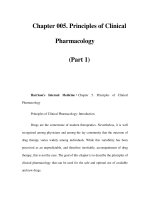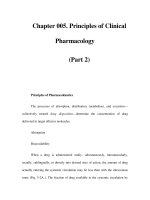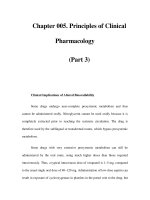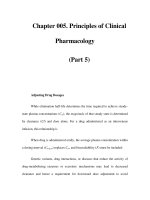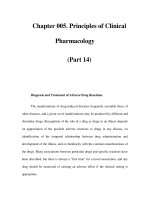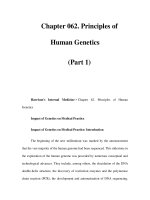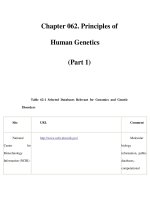Chapter 062. Principles of Human Genetics (Part 6) potx
Bạn đang xem bản rút gọn của tài liệu. Xem và tải ngay bản đầy đủ của tài liệu tại đây (122.22 KB, 4 trang )
Chapter 062. Principles of
Human Genetics
(Part 6)
The number of DNA sequences and transcription factors that regulate
transcription is much greater than originally anticipated. Most genes contain at
least 15–20 discrete regulatory elements within 300 bp of the transcription start
site. This densely packed promoter region often contains binding sites for
ubiquitous transcription factors such as CAAT box/enhancer binding protein
(C/EBP), cyclic AMP response element–binding (CREB) protein, selective
promoter factor 1 (Sp-1), or activator protein 1 (AP-1). However, factors involved
in cell-specific expression may also bind to these sequences. For example, basic
helix-loop-helix (bHLH) proteins bind to E-boxes in the promoters of myogenic
genes, and steroidogenic factor 1 (SF-1) binds to a specific recognition site in the
regulatory region of multiple steroidogenic enzyme genes. Key regulatory
elements may also reside at a large distance from the proximal promoter. The
globin and the immunoglobulin genes, for example, contain locus control regions
that are several kilobases away from the structural sequences of the gene. Specific
groups of transcription factors that bind to these promoter and enhancer sequences
provide a combinatorial code for regulating transcription. In this manner,
relatively ubiquitous factors interact with more restricted factors to allow each
gene to be expressed and regulated in a unique manner that is dependent on
developmental state, cell type, and numerous extracellular stimuli. As described
below, the transcription factors that bind to DNA actually represent only the first
level of regulatory control. Other proteins—coactivators and co-repressors—
interact with the DNA-binding transcription factors to generate large regulatory
complexes. These complexes are subject to control by numerous cell-signaling
pathways, including phosphorylation, acetylation, sumoylation, and
ubiquitinylation. Ultimately, the recruited transcription factors interact with, and
stabilize, components of the basal transcription complex that assembles at the site
of the TATA box and initiator region. This basal transcription factor complex
consists of >30 different proteins. Gene transcription occurs when RNA
polymerase begins to synthesize RNA from the DNA template.
Mutations can occur in all domains of a gene (Fig. 62-4). A point mutation
occurring within the coding region leads to an amino acid substitution if the codon
is altered. Point mutations that introduce a premature stop codon result in a
truncated protein. Large deletions may affect a portion of a gene or an entire gene,
whereas small deletions and insertions alter the reading frame if they do not
represent a multiple of three bases. These "frameshift" mutations lead to an
entirely altered carboxy terminus. Mutations occurring in regulatory or intronic
regions may result in altered expression or splicing of genes. Examples are shown
in Fig. 62-5.
Figure 62-4
Point mutations causing β-thalassemia as example of allelic
heterogeneity. The β-globin gene is located in the globin gene cluster. Point
mutations can be located in the promoter, the CAP site, the 5'-untranslated region,
the initiation codon, each of the three exons, the introns, or the polyadenylation
signal. Many mutations introduce missense or nonsense mutations, whereas others
cause defective RNA splicing. Not shown here are deletion mutations of the β-
globin gene or larger deletions of the globin locus that can also result in
thalassemia., Promoter mutations; *, CAP site;, 5'UTR;1 , Initiation codon;,
Defective RNA processing;, Missense and nonsense mutations;A, Poly A signal.
Figure 62-5
A. Examples of mutations. The coding strand is shown with the encoded
amino acid sequence. B. Chromatograms of sequence analyses after amplification
of genomic DNA by polymerase chain reaction.

